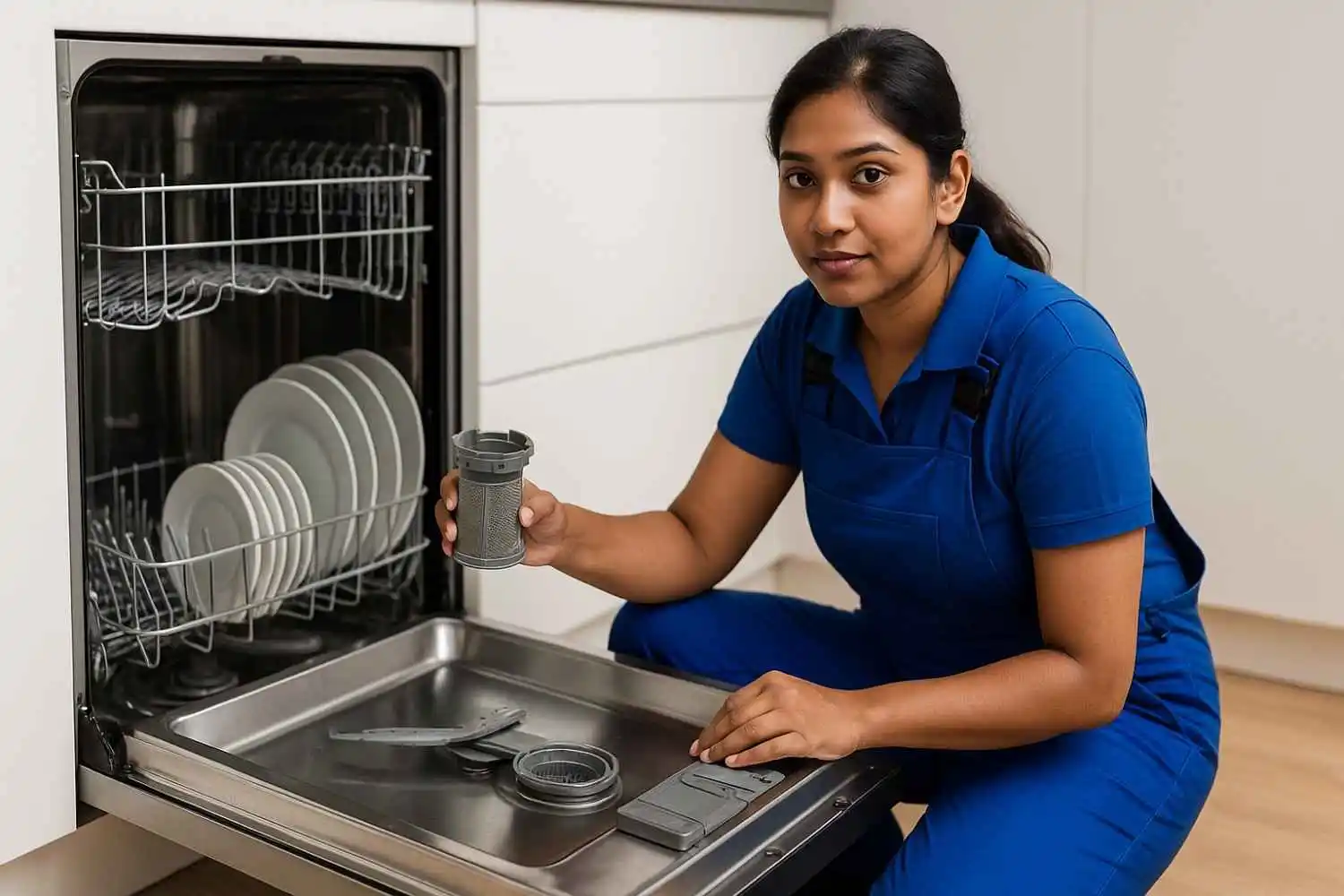Common Dishwasher Problems and How to Fix Them Leave a comment
Dishwashers earn their keep in modern kitchens by saving time, water, and sanity. Like any hard-working appliance, they occasionally act up. The good news? Most issues are simple to diagnose and even simpler to fix. In this guide, you’ll learn common dishwasher problems and how to fix them with quick DIY steps you can try before calling for service. New to the category? Start with the 10 Benefits of Using a Dishwasher. Shopping for one? Browse our latest dishwasher range.
Why Dishwashers Develop Problems
- Normal wear and tear: Moving parts—pumps, spray arms, and racks—age over time.
- Hard-water deposits: Limescale clogs jets and dulls heating efficiency.
- Incorrect detergent use: Regular dish soap foams, while the wrong tablets underperform.
- Poor maintenance habits: Dirty filters and blocked arms snowball into bigger faults.
Common Dishwasher Problems and Solutions
1. Dishwasher Not Draining
Likely causes: Clogged filter, blocked drain hose, or a kinked hose.
Dishwasher not draining fix:
- Power off and remove the lower rack.
- Lift out the filter; rinse and scrub gently.
- Inspect the sump for seeds, glass, or labels.
- Check the drain hose behind the unit for kinks or blockages; flush with warm water.
- Run a hot cycle with a cup of white vinegar to clear light buildup.
2. Dishwasher Not Cleaning Dishes Properly
Likely causes: Spray arm blockage, overloading, or wrong detergent.
Fix for dishwasher not cleaning properly:
- Pop off spray arms; rinse and clear each nozzle with a wooden toothpick.
- Load smart: face dirty surfaces toward the arms, separate nested bowls, avoid crowding.
- Use a manufacturer-recommended detergent and keep rinse aid topped up.
3. Dishwasher Leaking Water
Likely causes: Worn door gasket, loose hose connections, or a cracked inlet valve.
Fix for dishwasher leaking water:
- Wipe and inspect the door gasket; replace if torn or flattened.
- Tighten hose clamps at the inlet and drain points.
- If the inlet valve drips even when off, replace the part.
4. Dishwasher Making Strange Noises
Likely causes: Debris in the pump, utensil hitting a spray arm, or a failing motor/pump.
Fix:
- Stop the cycle, re-seat rattling utensils, and check the filter and sump for debris.
- Grinding or squealing that returns after cleaning usually points to a motor/pump issue—schedule service.
5. Dishwasher Not Drying Dishes
Likely causes: Heating element problem or no rinse aid.
Fix:
- Inspect the element for visible breaks; replace if faulty.
- Fill the rinse-aid dispenser and select a drying-boost option if available.
6. Dishwasher Smells Bad
Likely causes: Food trapped in the filter/sump or mold along the gasket.
Fix:
- Clean the filter and wipe the door gasket.
- Run a monthly cleaner cycle with a dishwasher cleaner or a cup of white vinegar.
7. Dishwasher Buttons/Controls Not Working
Likely causes: Control lock enabled, software glitch, or electrical fault.
Fix:
- Disable “Child Lock/Control Lock” if active.
- Power-cycle the unit for 5 minutes; try again.
- If the panel is unresponsive or flickers, arrange a technician visit.
Dishwasher Preventive Maintenance Tips
- Rinse the filter monthly; clean spray arms every 1–2 months.
- Run the kitchen tap hot for 20–30 seconds before starting a cycle.
- Use only dishwasher-safe detergents and the right dose.
- Avoid overloading; let water and detergent circulate freely.
- In hard-water areas, use rinse aid and a monthly cleaner to limit scale.
When to Call a Professional for Dishwasher Maintenance
- Electrical issues, burning smells, or tripped breakers.
- Loud grinding after you’ve cleared debris—likely pump or motor failure.
- Persistent leaks that continue after replacing the door gasket and tightening hoses.
- Error codes that won’t clear with a reset.
Conclusion
Tackle common dishwasher problems and how to fix them with calm, simple steps: clean the filter, clear the spray arms, check hoses, and use the right detergent. Quick fixes plus steady maintenance keep performance high and repair bills low. If your unit is past its prime, explore a new dishwasher. Want more context before you buy? Read the 10 Benefits of Using a Dishwasher.
FAQ
Why is my dishwasher not draining properly?
A clogged filter or blocked drain hose is common. Try the dishwasher not draining fix: clean the filter, check the sump, and flush the hose. Vinegar can help dissolve light buildup.
How do I fix a dishwasher that isn’t cleaning dishes well?
Clear spray arm nozzles, avoid overcrowding, and switch to a recommended detergent with rinse aid—classic steps when it’s dishwasher not cleaning properly.
What causes a dishwasher to leak water?
Usually a tired door gasket, loose clamps, or a cracked inlet valve. Address dishwasher leaking water by replacing the gasket and tightening connections; replace the valve if it still drips.
Why does my dishwasher make loud noises?
Debris can hit the impeller or arms. Remove obstructions first. Ongoing grinding or squealing points to a failing pump or motor—book service.
How do I fix a dishwasher that won’t dry dishes?
Confirm the heating element works and refill rinse aid. Use a drying-assist program if your model offers one.
Why does my dishwasher smell bad?
Food in the filter or mold on the gasket. Clean both and run a monthly cleaner or vinegar cycle.
How often should I maintain my dishwasher?
Clean the filter monthly, spray arms every 1–2 months, and run a cleaning cycle about every 30 days—more often with very hard water.
When should I call a professional for dishwasher repairs?
Electrical faults, persistent leaks, or repeated error codes warrant expert attention.

